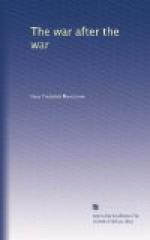The very next day Lloyd George and a great part of
the whole British
Nation knew exactly what Sir Hedley got out of his
interview with the
War Minister, because the first advertisement announcing
the new type of
War Loan read like this:
“ONE HUNDRED AND TWENTY-FOUR
CARTRIDGES FOR FIFTEEN AND SIX, AND
YOUR MONEY BACK WITH COMPOUND INTEREST
“Do you know that every
15/6 you put into War Savings Certificates
can purchase 124 rifle cartridges?
“How many Cartridges will you provide for our men at the Front?
“For every 15/6 you put
into War Savings Certificates now you will
receive L1 in five years’ time. This
is equal to compound interest
at the rate of 5.47 per cent.
“Each year your money grows as follows:
In 1 year it becomes 15/9
In 2 years it becomes 16/9
In 3 years it becomes 17/9
In 4 years it becomes 18/9
In 5 years it becomes L1
“If you need it you can
withdraw your money at any time, together
with any interest that has accrued.”
This advertisement made a good many people sit up because it brought home for the first time one concrete use of the money absorbed in war loans.
The National War Savings Committee had two things to sell. One was the Five Per Cent Exchequer Bond: the other was the new Fifteen and Six War Savings Certificate. The promoters were quick to see that while the Exchequer Bond was very desirable, the principal effort must be concentrated on the War Savings Certificate for which the widest appeal and the best selling talk could be made.
That it was a good “buy” nobody could deny. It was the obligation of the British Government: it was free from Income Tax: it could be cashed in at any time at a profit: and it made the owner part and parcel of the financing of the war. Every post office and nearly every bank became a selling agent. In short, it was a simple, cheap and worth-while investment absolutely within the scope of every one.
At the outset the sale was restricted to those whose income did not exceed $1,500, the purpose being to keep the investment among the wage earners. So many munition workers were receiving such large incomes that this ban was removed. The only limitation imposed was that no individual could hold more than 500 Certificates. This did not prevent the various members of a family, for example, from each acquiring the full limit.
Having decided to make the War Savings Certificate its prize commodity, the Committee proceeded to launch a spectacular, even sensational promotion campaign. J. Rufus Wallingford in his palmiest days was never more persuasive than the literature which now fairly flooded Great Britain.
The phrase “Your King and Country Need You” that had stirred the recruiting fever now had a full mate in the slogan “Saving for Victory” which began to loosen pounds and pence from their hiding places. The injunction that went forth everywhere was




